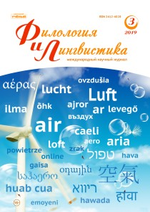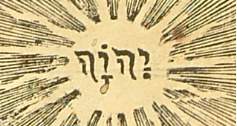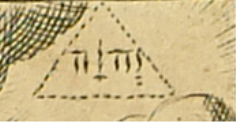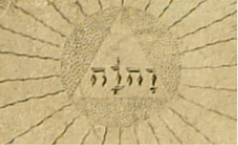Aspects of Rendering the Sacred Tetragrammaton in Medieval Slavic Religious and Secular Texts
Авторы: Василиадис Павлос Д., Борщевский Иван Сергеевич
Рубрика: История литературы
Опубликовано в Филология и лингвистика №3 (12) декабрь 2019 г.
Дата публикации: 20.10.2019
Статья просмотрена: 495 раз
Библиографическое описание:
Василиадис, Павлос Д. Aspects of Rendering the Sacred Tetragrammaton in Medieval Slavic Religious and Secular Texts / Павлос Д Василиадис, И. С. Борщевский. — Текст : непосредственный // Филология и лингвистика. — 2019. — № 3 (12). — С. 1-16. — URL: https://moluch.ru/th/6/archive/144/4511/ (дата обращения: 25.04.2024).
Key words: Tetragrammaton, Jehovah, Yahweh, nomina sacra, Slavic languages, Church Slavonic, Middle Ages, divine name(s)
A Russian orientalist, Professor of the Kazan Theological Academy Gordy S. Sablukov begins his work Comparison of the Islamic Doctrine of the Names of God with the Christian One with the following statement: «With full consciousness of the importance of what I am talking about, with due reverence for God, I tell you that Christians know the great name of God». [1]
Not so many issues in the history of world religions has caused so much controversy, as the question about the use and proper pronunciation of the ancient name of God that is found in the Hebrew text of the Old Testament about seven thousand times and consists of four letters יהוה, and is therefore called the Tetragrammaton (from the Greek words τετρα «four» + γράμμα «letter»). It is believed that the exact pronunciation of the theonym has been lost. It is commonly pronounced as Yahweh or Jehovah. Various Bible translators, theologians and scholars have not yet come to a consensus on what vowels should be used in this word.
At the end of the 19th century, Akim Olesnitsky, Professor of the Kiev Theological Academy, a famous Russian biblical scholar, complained that the problem of the ancient name of God had not been studied thoroughly by Russian researchers. [2] Since then, much has been written on this topic. However, the problem of rendering of the Tetragrammaton in Medieval Slavonic texts has not been studied thoroughly to date. Some studies [3] dwell on aspects of translations of such Hebrew names of God as El-Shadday (God Almighty) or ’ehyeh ’asher ’ehyeh (I Am Who I Am), but do not discuss the rendering of God’s proper name. Therefore, the aim of this study is to analyze medieval religious and secular texts written in several Slavic languages (Church Slavonic, Russian, Belarusian, etc.) and to summarize methods of rendering of the Tetragrammaton applied therein.
Views on the proper name of God and its structure
A Russian theologian, Ivan Dmitrievsky stated that “among all various names of God existing in all languages and in all nations of the world, no one describes God's identity in a more glorious way, than his mysterious name Jehovah.” [4] Therefore, although Russian religious writers followed Greek Orthodox theologians and believed that the Creator had multiple names, such as Lord, God, etc., at least some of them emphasized the uniqueness of his proper name.
Several texts provide details on the structure of God’s name. As early as in 1073, this question was discussed in the so-called 1073 Svyatoslav’s Izbornik (an anthology of various texts collected for Prince Svyatoslav in 1073), the oldest Russian dated manuscript. It quotes Theodoret of Cyrus and says: “Пишеть же сѧ четырьми съставы. Тѣмь же и четверописменьно наричѫть” (It is written in four consonants, and so they speak of it as the “Tetragrammaton”). [5, p. 154][1]
Josephus’s Jewish War was translated into the Old East Slavic language in the 12th century. [10] The book was very popular in the Medieval Russia, and it also provided some information about God’s name. While describing high priest’s garments, Josephus mentions God’s name written in sacred letters.[2]
The Russian Orthodox Church had very close relations with the Greek one, therefore, while rendering God’s proper name, Russian scribes and translators used to follow Greek authors. The methods applied by them can be divided into three groups:[3]
- Non-translation;
- Semantic translation
- Transliteration and transcription
Non-translation
This practice means that translators and scribes simply transfer the Tetragrammaton in the original writing, i.e. with four Hebrew letters. Some examples may be found in several Septuagint manuscripts, where the theonym was written in both square and paleo-Hebrew script.
1)יהוה
No Slavic Bible versions with the Tetragrammaton rendered in its original form have been found to date. However, the four Hebrew letters representing it (יהוה) can be found in early editions of the Elizabeth Bible (Russian: Елизаветинская Библия), the authorized version of the Russian Orthodox Church printed in Church Slavonic in 1751. The Tetragrammaton in the original form can also be found on title pages of Psalters published in the 18th century. (Table 1)
Table 1
The Teragrammaron in its original form in Bibles printed in the 18th century
|
Tetragrammaton |
Vocalization |
Source |
|
|
E-O-A |
Psalter, 1742 [38] |
|
|
E-O-A |
Psalter, 1747 [39] |
|
|
E-O-A |
Psalter, 1773 [40] |
|
|
A-O-A (with vav instead of the initial yod) |
Bible, 1784 [41] |
So, the readers of the Church Slavonic Bible were able to see the Tetragrammaton written in the square Hebrew script.
In the 17th century, Johannes Piscator’s Theatrum Biblicum hoс est historiae cacrae was published in Russia. It contained illustrations to the biblical text, where the Tetragrammaton was often displayed in the original form. (Fig. 1)
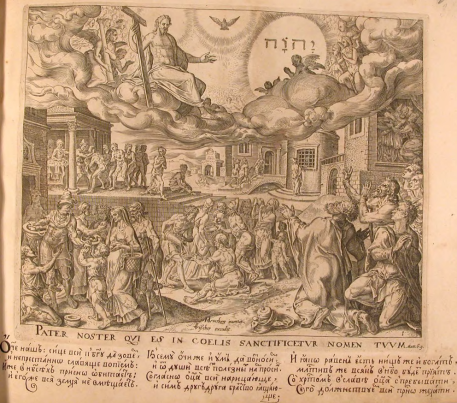
Figure 1. An illustration to Matthew 6:9, “Thy Name Be Praised”
2) ТЕТРАГРАММАТОНЪ (Tetragrammaton)
Gennadius, the Archbishop of Novgorod the Great and Pskov, ordered Dmitry Gerasimov, also known as Demetrius Erasmius, Mitya the Translator, and Dmitri the Scholastic, a Russian translator, diplomat and philologist, to translate several Western tracts aimed at combating the Muscovite-Novgorod Heresy (the so-called Heresy of Judaizers) at the close of the 15th century. One of them, Probatio adventus Christi (in Russian: “Доказательство пришествия Христа”, translated in 1501) by Nicholas of Lyra, a Franciscan scholar, contained God’s name in the form of “Tetragrammaton” (Тетраграмматон):
“В еврейском языке существует три Божественных имени, а именно: Эл, Элоим и имя Господа Тетраграмматон...” (“There are three Divine names in the Hebrew language, namely El, Elohim, and the name of the Lord Tetragrammaton…”) [11]
He quotes several verses from the Bible where the original Hebrew יהוה is rendered as “Tetragrammaton”. For example:
“Так же и у Иеремии XXIII: «Вы извратили слова Бога живущего, Господина воинств, Бога вашего Тетраграмматон».” (“Also in Jeremiah XXIII: «Ye have perverted the words of the living God, of the Lord of hosts, your God Tetragrammaton.”) [11]
The author explains that the word “Lord” stands for the Tetragrammaton:
“То же и в книге Бытия XXII, говорится: «И нарек Авраам имя месту этому: Господь видит», — где мы видим, что в еврейском тут «Господь» ставится как Тетраграмматон”. (“The same is in Genesis XXII: «And Abraham called the name of that place: Lord sees», where we see that in Hebrew, " Lord” here is written as “Tetragrammaton”. [11]
It is an unusual form of rendering YHWH (יהוה) into Russian and resembles the Hebrew tradition to use the expression haShem (“the Name”) instead of God’s name; however, it means that Medieval Slavic scholars were familiar with God’s proper name and used it in their religious arguments.
Semantic translation
The basic rule concerning personal names is that they are left untranslated. However, in some cases, Bible translators preferred semantic translation of the theonym. Although they dealt with a proper name, they tried to find an equivalent in the target language based on a specific understanding of the meaning of the Tetragrammaton or a theologically motivated selection of specific characteristics or roles of the Divinity.
1) ГОСПОДЬ/Г҇Ь/Г҇ДЬ (Lord)
As the Septuagint replaced the Tetragrammaton with the Greek word κύριος within the later Christian textual tradition, the latter was translated with its Slavonic equivalent ГОСПОДЬ. G. Sablukov explains: “While citing the words of the prophets from the Old Testament and translating them into Greek, in which they conveyed the gospel teaching, both Apostles and Evangelists replaced the great name of God with the word «Lord» thus following the example of the 70 translators. In the Slavonic translation of the Bible, the great name of God, which is found in the original language of the Old Testament, i.e. the name of Jehovah, is not mentioned for the reason shown above”. [1]
In fact, the word ГОСПОДЬ (“Lord”) is a substitute term, and is neither a translation nor an exact synonym of the Hebrew Tetragrammaton. A Russian Biblical scholar and translator S. Averintsev wrote: “The translation of the Bible into Greek predetermined a number of issues that emphasize the universalization of Judaism once again. A strict ban was imposed on a “four-letter” name Yahweh used by Jews; so while reading it out loud, ketib (“writing”) was substituted for the qere (“reading”) “Adonai,” i.e. “the Lord”. One way or another, however, the revered and unspeakable name was preserved in the text, reminding of the exclusivity of the worshipers of this name. But when translated into Greek, it was dropped completely, replaced with Κύριος, “Lord”, in the written text itself (that is why Christian authors call their God just “Lord”). Being exotic to the Hellenic ear, the name disappeared; but a concept of God as “Lord” in general, the Lord of not Jews alone but of the whole world remained. This significant change is not the only one. As a Russian philologist notes, ‘LXX does not usually translate, but rather interpret.’” [12][4]
2) АДѠНАИ/АДОНАИ/АДАНАИ (Adonai)
Sometimes the translators had to differentiate between the title “Lord” and the theonym in such expressions as “Adonai YHWH”. Translators of the book of Ezekiel in several Slavonic versions decided to demonstrate the difference between the two words by using the expression “АДѠНАИ/АДОНАИ ГОСПОДЬ” (Adonai Lord) to translate the original phrase “Adonai YHWH” (Fig. 2 and 3).

Figure 2. Ezekiel 3:11. The Elizabeth Bible, 1751. АДѠНАИ Г [ОСПО]ДЬ for Adonai YHWH

Figure 3. Ezekiel 3:11. The Ostrog Bible, 1581. АДОНАИ Г [ОСПОД]Ь for Adonai YHWH
By doing this, the translators followed the Septuagint (Ἀδωναὶ Κύριος) and rendered אֲדֹנָ֣י by transcribing it as АДОНАЙ and יְהֹוִ֑ה by using the nomen sacrum Г҇ДЬ/Г҇Ь.
The words АДАНАИ/АДОНАИ are also found in the translation of the Book of Lamentations made by the so-called Heresy of Judaizers[5] (Fig. 4) and Francysk Skaryna’s translation. (Fig. 5)

Figure 4. Lamentations 1:15 from the translation of the Book of Lamentations made by the so-called “Heresy of the Judaizers” [13]

Figure 5. Exodus 6:3. Francysk Skaryna, 1517
There are several 15–16th century manuscripts of the Pentateuch, where the Slavonic text is amended in accordance with the Hebrew text [3]. It was assumed that, at first, these manuscripts were used by Jews as targums and the former corrected the text in accordance with the Jewish tradition. Then the manuscripts were used by Orthodox Christian copyists who even introduced the marginal notes into the main text. Some of these notes referred to transliteration of the Hebrew expression ’ehyeh ’asher ’ehyeh in Exodus 3:14. The scribes considered it a proper name, which should be replaced with the title Adonai while reading (Fig. 6)

Figure 6. Exodus 3:14, 15 in the Pentateuch from the 16th century Pogodinsky collection. The main text reads “I am ’ehyeh ’asher ’ehyeh,” while the marginal text says “Adonai, Lord of Armies”. At the beginning of verse 15 (“Lord, God of your fathers”) there is a marginal note “Adonai” referring to the word “Lord”
In 1 Samuel 1:11, some versions follow the extended LXX text “αδωναι κύριε ελωαι σαβαωθ” and render it as АДѠНАИ/АДАНАИ ГОСПОДЬ ЭЛОИ САВАѠѲЪ (Adonai Lord Eloi Sabaoth). (Fig. 7 and 8)

Figure 7. 1 Samuel 1:11. The Elizabeth Bible, 1751

Figure 8. 1 Samuel 1:11. Old Testament, 15th century Solovetsky collection
This reverential amassing of transliterated divine epithets is not to be found in the Masoretic text. Some researchers consider it “an expression of the various strata of revision”[6] of the Greek text while others as a reflection of another version of the Hebrew Bible. [3][7]
3) БОГЪ (God)
As in the Septuagint, the word “Богъ” (God) was used in a number of verses instead of the Tetragrammaton. Some translators used capital letters to distinguish between the word “God” as a translation of the Tetragrammaton and the word “god” used to render “ο θεός” or אלוהים. For example, Ambrosios, the archbishop of Moscow, translated the book of Psalms in the second half of the 18th century (before 1771). In a footnote to the word “God” (“God’s law”) in verse 2 of the first Psalm he wrote: “In the Hebrew language, this word means «Jehovah» (Iегова); therefore, hereinafter, in this Psalter, this word is written in capital letters in the translation to make it recognizable.” (Fig. 9)
A

B

Figure 9. A — Archbishop Ambrosios’s translation of Psalm 1:2 with a footnote. B — Psalm 7:4 [7:3 in the Masoretic text] were the word ”Боже” (a vocative case for “Бог”) standing for YHWH is written with a capital letter “Б”, and the second word “боже” for “elohay” (“my God”) is written with a small letter “б”
4) СЫЙ/СУЩИЙ (“He that Is”)
This Slavonic word corresponds to the Greek “ὁ Ὢν”. Apparently, Philo of Alexandria was the first to consider the phrase “He that Is” God’s proper name. Actually, these two words used by the Septuagint and their Slavonic equivalent do not render the sacred Tetragrammaton. [16][8] However, the terms СЫЙ and СУЩИЙ have been used by Orthodox scholars as a translation of YHWH for centuries. [17]
The earliest Slavonic translation of this phrase can be found in the 1073 Izbornik (manuscript with collected writings), “Азъ ѥсмь сѧй” (Az yesm’ syi, I am “He that Is”). [18] The Tetragrammaton is translated as СЫЙ in several occurrences in the Elizabeth Bible. (Fig. 10)

Figure 10. Jeremiah 14:13. The Elizabeth Bible, 1751. СЫЙ ГДИ БЖЕ (“He That Is” Lord God) for YHWH Adonai
Orthodox scholars claim that “being different in their grammatical forms, both words, Iегова (Jehovah) and Сый (He That Is), have the same internal sense… the Orthodox Church uses the name Сый as a translation of Jehovah's name.” [1] The Explanation of the Liturgy, published by the Holy Synod (Moscow, 1823), says: “The Holy Eucharist Prayer in the Liturgy of St. Basil the Great begins with the word СЫЙ, “Сый Владыко, Господи Боже Отче Вседержителю покланяемый!” (Syi, Master, Lord, God, worshipful Father almighty). This word corresponds to the Jewish name of God, JEHOVAH”. [1]
Transcription and transliteration
1) АВѢ/ ЇАВЕ/ ѨВѢandАИѨ / АїА / ИАѦ (Jave and Aia)
These forms were borrowed from Greek authors and were transferred into Slavic texts.
The first occurrence of this transcription of God’s name can be found in 1073 Svyatoslav’s Izbornik. It contained a translation of the comment made by Theodoret of Cyrus on Exodus 6:3:
“What is the meaning of «My name ‘Lord’ I did not make known to them»?
This conveys the great honor and kindness with which God treated Moses. Declaring, «I am who am», he disclosed to Moses the name he had never revealed to the patriarchs. Among the Hebrews this is known as the unspoken name; they are forbidden to utter it aloud. It is written in four consonants, and so they speak of it as the «Tetragrammaton». This name was also inscribed on a plate of gold worn on the forehead of the high priest and bound to his head. The Samaritans call it «Iabe»,” the Jews «Ia».” (Fig. 11)
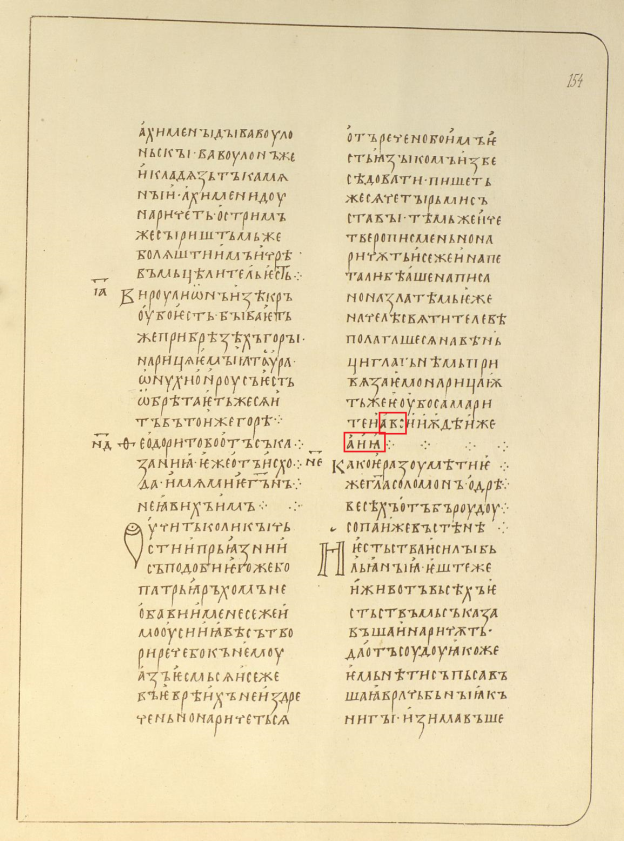
Figure 11. 1073 Izbornik. Theodoret’s comment on Exodus 6:2
The 9th century Chronicle of George Hamartolos was translated into Russian approximately in the 11th century. It contained a story borrowed from Josephus describing the meeting of Alexander the Great with the Jewish high priest. The story of Alexander’s life and works became very popular with Russians and it was called Alexandria. Giving a description of the high priest’s garments, the author mentions the golden plate engraved with the name of God (the text is obviously taken from Theodoret’s work): “This name was also inscribed on a plate of gold... The Samaritans call it «Iabe», the Jews «Ia».”
The Chronicle of George Hamartolos existed in Russia in two versions: Bulgarian and Serbian. (Fig. 12 and 13)
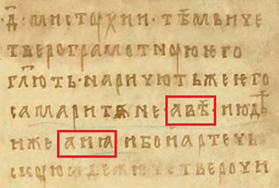
Figure 12. ‘Bulgarian’ version of the Chronicle of George Hamartolos

Figure 13 ‘Serbian’ version of the Chronicle of George Hamartolos
The same text of Alexandria was included into the 15th century Greek and Roman Chronicles.

Figure 14. Greek and Roman Chronicles
It can be also found in the Illustrated Chronicle of Ivan the Terrible (the so-called Tsar-Book) written by the order of Tsar Ivan the Terrible in 1568–1576.

Figure 15. Illustrated Chronicle of Ivan the Terrible
2) IАѠ (Iao)
This form is found in Tolkovaja Paleja.[9] It contains the Biblical text with apocryphal insertions. One of them known as the Ladder of Jacob, a story of Abraham’s grandson, is inserted into the Biblical account of Genesis 28:9–11. The text has been preserved only in Slavonic. In the apocryphal song of praise, Jacob sings of God: “Twelve-topped, twelve-faced, many-named, fiery one! Lightning-eyed holy one! Holy, Holy, Holy, Yao, Yaova, Yaoil, Yao, Kados, Chavod, Savaoth.”

Figure 16. 1477Tolkovaja Paleja
Maximus the Greek translated the Book of Psalms with catenae in the 16th century. In the comment on Psalm 104 (103) the book says that “Hallelujah” means “Praise God Iao”, and “Iao was left untranslated by Jews as the name of God.”[10]

Figure 17. Psalms with catenae translated by Maximus the Greek, 16th century
Whether a substitute term or an actual rendering of the Tetragrammaton, the Greek form Ιαω played a major role in the transmission and interpretation of the Biblical text, originally among the Jewish communities of Egypt and later in the Christian sacred literature. [36]
3) IАѠИЛЪ / IАОИЛЪ / ИѠИЛЪ (Yaoel or Yoel)
This unusual form is found in some Biblical apocrypha.
The word IAѠИЛЬ is a transcription of two Hebrew terms — Yao, which stands for YHWH, and El (God), therefore, it means “YHWH God.” The name Yaoil/Yaoil (transcribed by some authors as Jaoel) is found in some apocryphal books (e.g. the Third Book of Enoch) as a name of an angel, but in the Ladder of Jacob it is used as a name of God. It is found in Paleja 1477. (Fig. 16)
It is also found in the apocryphal Apocalypse of Abraham. As with the Ladder, it is known only in the Slavic version, although it may have been originally composed in Hebrew. The Apocalypse also contains the name Yaoil (Jaoel) as an angel’s name, but in one verse (17:13), in the song of praise, it refers to God.
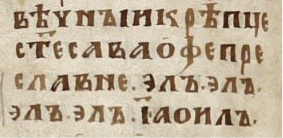
Figure 18. Apocalypse of Abraham. Prayer: “вѣчныи крѣпце с [вѧ]те Саваофе преславне. элъ. элъ. элъ. элъ. Іаоилъ” (Eternal, mighty holy Sabaoth, very glorious El, El, El, El, Jaoel!) G. Box states that “the fourfold El looks like a substitution for the Tetragrammaton; Jaoel (here applied to God) is undoubtedly so” [19]
This form is also found in the apocryphal Life of Adam in Eve which is a Russian version of the Apocalypse of Moses. Russian translators mistook Joel for an angel’s name, however, in the original Greek text it refers to Jehovah God — Ἰαήλ (Yah El).
4) IАѠВА (Iaova)
This form is found in Paleja 1477. (Fig.16)
5) ИѦ (Ia)
This shortened form of the Tetragrammaton is found in the commentary on Psalm 104 (103) in the Book of Psalter (Psalterium beati Brunonis episcopi herbipolensis), a collection of commentaries written by Bruno of Würzburg (c. 1005–27 May 1045) and translated into Russian by Dmitry Gerasimov in 1535 (or 1536). It explains the word “Hallelujah” and says that “Ia refers to the invisible God”.

Figure 19. Psalterium beati Brunonis episcopi herbipolensis translated into Russian in the 16th century
6) ѨГЪ, ѨГ (Yah)
Not long ago, a unique document was discovered in the Russian State Archive of Early Acts. It may be called the Cyrillic Manual of Hebrew. [20] The manuscript is an East Slavic copy of Miscellany and, according to its watermarks, dates back to the third quarter of the 16th century. The Manual contains the following information: a) Hebrew texts transcribed in Cyrillic (Gen 32.27–28; Psalm 150; So 3.4 (or 8.2), 8.5; Is 11.12); b) a bilingual Hebrew-Ruthenian glossary with explanatory notes; and c) certain quotations from the Slavic translation of three Old Testament books (Genesis, Isaiah, and Song of Songs) which illustrate some entries of the Hebrew-Slavic glossary.
The transcription of Psalm 150 is of great interest, because there are three occurrences of יה (Yah), a shortened form of the Tetragrammaton.
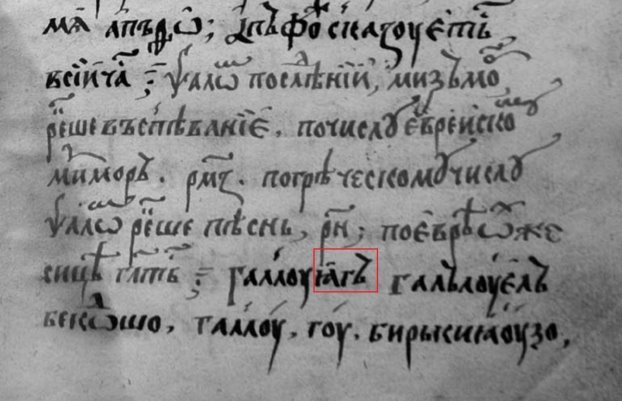
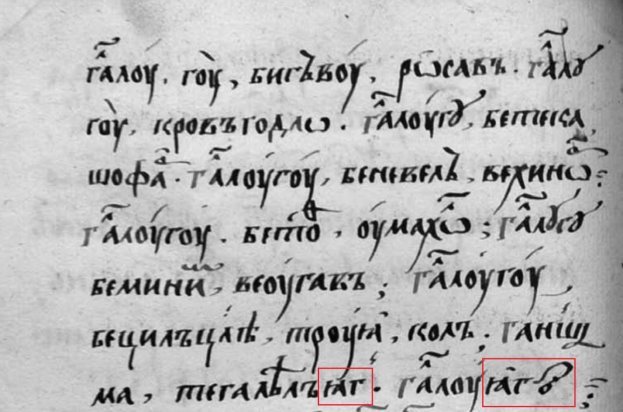
Figure 20. Transcription of Psalm 150 in the Cyrillic Manual of Hebrew
In all three cases, יה is transcribed as ѨГЪ and ѨГ (Yah). S. Temchin provides evidence that at least some psalms (including this one) must have been sung or recited in Hebrew by certain groups of East Slavs in the Grand Duchy of Lithuania, Novgorod the Great, and Muscovy during the 15–16 centuries. [21]
7) IЕГОВА/ЕГОВА (Jehovah)
It seems that Szymon Budny, a Polish and Belarusian humanist, Bible translator, Protestant reformer, philosopher, sociologist and historian, was the Slavic author who used the form Егова in his works. On June 10, 1562, in co-authorship with Wawrzyniec Krzyszkowski, he published a Ruthenian translation of M. Luther’s Catechism in Nyasvizh, Belarus.[11]

Figure 21. Szymon Budny Catechism: “The names are as follows: Adonai, Saddai, Jehovah, Sabaoth…” A 17th century handwritten copy of the book printed in Nyasvizh, 1562 [42]
In 1572, his Bible translation into Polish known as Biblia Nieświeska was published. In the Old Testament, the Tetragrammaton was rendered as Jehowa. In 1574, he published his translation of the New Testament in Łosk, Belarus. It seems that Budny was the first to use the name Jehowa in a Slavic version of the New Testament. (Fig. 22)

Figure 22. Matthew 1:20 in Budny’s translation of the New Testament (1574)
Ławrentij Zyzanij-Tustanowski, a Ruthenian linguist and theologian, published his version of the Catechism in 1627. He used the form Еговагъ (Jehovah) to render the Tetragrammaton. (Fig. 23)

Figure 23. Zyzanij’s Catechism [43].
Peter Mogila (Mohyla), an influential Ruthenian Orthodox theologian and reformer, Metropolitan of Kiev, Halych and All Rus', used the form Iегова in his works. His Orthodox Confession of the Catholic and Apostolic Eastern Church was in all probability composed in Latin in 1638 (although it is possible that there were also Slavic—most likely, Polish or Ruthenian—drafts). The Confession was accepted after elaboration by the Council of Kiev in 1640 and by the Council of Jassy (Moldavia) in 1642. Consequently, an amended version in vernacular Greek (“πεζῇ τῇ φράσει”) was prepared by the Greek theologian Meletios Syrigos. This version was promptly reviewed and officially approved by the four patriarchs of the ancient Eastern Orthodox Churches in 1643. It was published for first time in 1666 in Greek with the support of the Greek Grand Dragoman Panagiotis Nikousios. In 1696 it was translated from Greek into Church Slavonic and in 1830 it was translated into Russian. Following this path, the Latin Jehova became the Greek Ἰεχωβᾶ, and, later on, the Russian Iегова.
Since then, this Russian form has been used by many authors of catechisms. For example, Plato II (Platon Levshin), the Metropolitan of Moscow, used this name first in his handwritten catechism (1757) and then in the one published in Moscow in 1781. (Fig. 24)
A.

B.

Figure 24. Plato’s catechism [22]
As for the known Bible translations, it can be assumed that for the first time this form appears in Archbishop Ambrosios’s translation of Psalms in the second half of the 18th century. (Fig. 9 above)
Conclusion. Our research demonstrated that Slavic authors rendered the Tetragrammaton in different ways: non-translation, semantic translation, transcription and transliteration. The first known mentioning of God’s proper name in Slavic texts dates back to the 11th century (Chronicle of George Hamartolos and 1073 Izbornik).
Appendix 1.
God’s name and cryptolects of the Western regions of the Russian empire
АХВЕСЪ/ЯХВЕСЪ
This word is found in cryptolects (argots, professional slangs or secret languages) of the Western Russia, Belarus, and Ukraine[12] in the form of “akhves/yakhves” (and some other variants listed below in Table 2) and means “god”.[13] A number of scholars have proposed that this word originates from the Tetragrammaton, YHWH, and has appeared in these argots due to Judeo-Slavic contacts, mainly, in Belarus. [23, 24, 25, 30][14]
Table 2
The word “god” in some cryptolects of the Western Russia, Belarus, and Ukraine (based on [26, 29]).
|
Social group |
“God” |
|
Chernigov fullers |
Ахвес (Akhv’es) |
|
Chernigov beggars (Kîiinka) |
Охвис (Okhvis) |
|
Chernigov beggars (Pochep) |
Ахвес (Akhv’es) |
|
Drybine fullers |
Ахвес (Akhv’es) |
|
Bryansk beggars |
Ахвес (Akhv’es) |
|
Belarusian elders |
Ахвес (Akhv’es) |
|
Minsk beggars |
Ахвэс (Akhves) |
|
Mogilev (Mahilioŭ) beggars |
Ахвес (Akhv’es), Яхвес (Yakhv’es) |
|
Grodno beggars (labori) |
Ахвэс (Akhves), Охвесь (Okhv’es’) |
|
Kiev lyrnics (singers accompanying themselves on lyre) |
Хвесь (Khves’) |
|
Galicia lyrnics (1894) |
Фез (Fez)[15] |
|
Galicia lyrnics (1895) |
Охвес (Okhves) |
|
Glasscutters of Village Ladva, Olonets Governorate |
Ефес (Yef’es) |
In some argots this word produced such expressions as “ахвеса ёнус” (“akhv’esa yonus” = “Jesus Christ”, literary “Yahweh’s son”) [27] and “яхвесу чинаться”, “ахвесаться”, “ахвэса зитати” (“yakhvesu chinat’sya, akhv’esat’sya, akhvesa zitati” = “pray”, literary “talk to Yahweh”). [23, 29] K. Studinski quotes the words of one prayer in the beggar’s cryptolect: “О, фез комунесткий, до тебе кизетаю” (“O fez komunes’kii, do tebe kizetayu” = “O God of Mercy, I pray to you”). [30]
Appendix 2.
God’s name used by the members of the Khlysty sect
ЕГА (Yegah)
This form of God’s name is found in Khlysty’s prayers. Khlysty (хлысты) is a Russian mystical sect, which developed inside the Orthodox Church by the middle of the 17th century. This religious group has no sacred writings, and their beliefs are spread in the oral form. They call themselves «христововеры» (khristovovery, «Christ-believers») or Христы (Khristy, “Christs”). During one of their ecstatic rituals they formed circles (men were in one circle and women were in the other one), with one circle inside the other, then they began to go round very quickly and repeated the words of prayer: “Oh spirit! Oh spirit! Oh spirit! Oh God! Oh God! Oh God! King God! King God! King God! King Spirit! King Spirit! King Spirit! Oh Yegah! Oh Yegah! Oh Yegah! (In Russian: “Ой дух! ой дух! ой дух! ой бог! ой бог! ой бог! царь бог! царь бог! царь бог! царь дух! царь дух! царь дух! о Ега! о Ега! о Ега!”). T.Butkevich explains that this ritual was aimed to present the vision of a wheel inside a wheel in the book of Ezekiel, and the name Ега (Yegah) referred to Iегова (Jehovah). [32]
Appendix 3.
Theonym (I)ЕГОВА in official documents of the Russian Empire (18th century)
The use of the theonym Jehovah was not restricted to religious texts. It was used in the peace treaty between Russia and Persia concluded on January 21, 1732. (Fig. 22) [33]
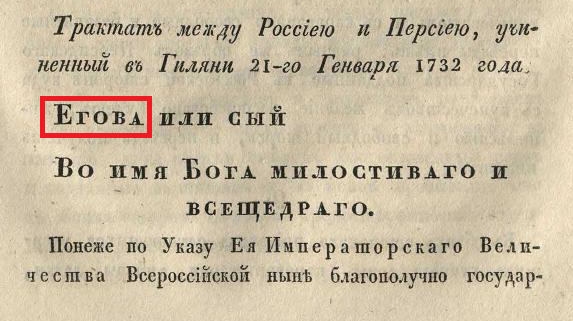
Figure 25. The 1732 treaty between Russia and Persia.
References:
- Саблуков Г. С. Сличение магометанского учения об Именах Божиих с христианским о Нём учением. Казань, 1872. — 200 c.
- Олесницкий А. А. О древнем имени Божием // ХЧ, 1887, май, с. 3–37.
- Успенский Б. A. Имя Бога в славянской Библии (к вопросу о славяно-еврейских контактах в Древней Руси). Вопросы языкознания. № 6, 2012, с. 93–122.
- Дмитревский И. И. Историческое, догматическое и таинственное изъяснение на литургию. Москва, 1823. С.2.
- Изборник великого князя Святослава Ярославича 1073 г. СПб., 1880 (фототип. изд.) — 266 л.
- Полное собрание русских летописей. Том 22. Русский хронограф. Часть первая: Хронограф редакции 1512 года / под ред.: С. П. Розанов; издано по высочайшему повелению Императорской археографической комиссией. — СПб.: типография М. А. Александрова, 1911. — 568 с.
- Полное собрание русских летописей. Том 22. Русский хронограф. Часть вторая: Хронограф западнорусской редакции / под ред.: С. П. Розанов; издано по высочайшему повелению Императорской археографической комиссией. — СПб.: типография М. А. Александрова, 1914. — 289 с.
- Лицевой летописный свод XVI века в 40 томах. Учебник жизни для царских детей. Александр Македонский. Книга 6. Москва. В лето 2020 от воплощение Господа нашего Иисуса Христа и от Адама в лето 7520.
- Жития святых. Книга вторая. — К.: Тип. Киево-Печерской лавры, 1764.
- «История Иудейской войны» Иосифа Флавия. Древнерусский перевод. Том I. Москва: Языки Славянской Культуры. — 2004. 880 с.
- Николай де Лира. Доказательство пришествия Христа. Латинский теологический трактат и его перевод на церковнославянский язык, выполненный Дм. Герасимовым в начале XVI века. Перевод на русский язык, предисловие, аналитический обзор, указатель слов и словоформ Е. С. Федоровой. Москва — «Просветитель» — 1999. 285 с.
- Аверинцев С. С. Греческая «литература» и ближневосточная «словесность» (противостояние и встреча двух творческих принципов) // Риторика и истоки европейской литературной традиции. М.: Школа «Языки русской культуры», 1996. С. 13–75.
- Белокуров С. А., Долгов С. О., Евсеев И. Е., Соколов М. И. О ереси жидовствующих: Новые материалы (Чтения в Императорском Обществе истории и древностей российских при Московском университете, кн. 3), Москва 1902, с. 127–164.
- Яцимирский А. И. Апокрифы и легенды: К истории апокрифов, легенд и лож. молитв в юж.-слав. письменности. Вып. 1. Петроград: тип. Акад. наук, 1915. — 404 c.
- Майков Л. Великорусские заклинания. Санкт-Петербург Типография Майкова. 1869. — 164 c.
- Шукуров Д. Л. Имя Бога в культурологическом дискурсе. Соловьёвские исследования. Выпуск 3(39) 2013:149–160.
- Антоний (Булатович), иеросхимонах. Апология веры во Имя Божие и во Имя Иисус // Имяславие. Антология. М.: Изд-во «Факториал Пресс», 2002. С. 9–160.
- Успенский Б. А. Из истории славянской Библии: славяно-еврейские языковые контакты в Древней Руси (на материале nomina sacra). Вопросы языкознания. № 5 2014, с. 24–55.
- Box G. H. (ed., with the assistance of Langman J. I.). The Apocalypse of Abraham. London: S. P. C.K.; New York: Macmillan, 1918. Р.38.
- Темчин С. Ю. Кириллический рукописный учебник древнееврейского языка (XVI в.): публикация и общая характеристика памятника, in Meiliūnaitė V., Morozova N. (eds.), Naujausi kalbų ir kultūrų tyrimai. Vilnius (Kalbų ir kultūrų sankirtų archyvai, kn. 4), 2012. С. 137–180.
- Темчин С. Ю., 2012b: Пели ли православные восточные славяне XV–XVI веков псалмы по-древнееврейски, in Pawluczuk U. (ed.), Język naszej modlitwy — dawniej i dziś. Białystok (Latopisy Akademii Supraskiej, vol. 3), с. 19–26.
- Катехизис, или первоначальное наставление в христианском законе, толкованное всенародно, 1757 и 1758 гг., ч. 2. М., 1781.
- Арапов М. В. К этимологии слова «офеня». // Этимология. Принципы, реконструкции и методика исследования. М., 1965. С.120–125
- Цыхун Г. А. Этымалагічны слоўнік беларускай мовы. Минск: Акадэмія навук БССР; Беларуская навука, 1978–2006. Т. 1, стр. 214
- P. Wexler. Explorations in Judeo-Slavic Linguistics. Leiden:Brill, 1987. pp. 200–201.
- Приёмышева М. Н. Тайные и условные языки в России XIX в. Ч. II. СПб.: Нестор-История, 2009. — 696 с.
- Тиханов, Павел Никитич. Тайный язык нищих: этнологический очерк. — Брянск, 1895. — 34 с.
- Бондалетов В. Д. Условные языки русских ремесленников и торговцев. Рязань: Рязанский государственный педагогический институт, 1980. C. 80.
- Романов Е. Белорусский сборник. Вып. 8–9. Быт белоруса; Опыт словаря условных языков Белоруссии. Вильна: Типография А. Г. Сыркина, 1912. 124 c.
- Kostb Viktorin [Кирил Студиньсций] “Дедовска (жебрацка) мова” (“Зоря” 1886, Львов, стр. 237).
- Арапов М. В. Откуда слово «офеня»? «Русская речь», 1968, № 4, с. 117–119.
- Буткевич Т. Обзор русских сект и их толков. Харьков, 1910. С. 51.
- Бутурлин Д. П. Военная история походов россиян в XVIII столетии. Военная Типография Главного Штаба Его Императорского Величества. Часть вторая. Том IV. 1-я половина. СПб.1823, c. 236.
- Pavlos Vasileiadis. Aspects of rendering the sacred Tetragrammaton in Greek, Open Theology, Vol. 1 (2014), pp. 56–88.
- Pavlos Vasileiadis, Nehemia Gordon. Transmission of the Tetragrammaton in Judeo-Greek and Christian Sources, Accademia: Revue de la Société Marsile Ficin, Vol. 18 (2019). [In press]
- Pavlos Vasileiadis. The god Iao and his connection with the Biblical God, with special emphasis on the manuscript 4QpapLXXLevb, Vetus Testamentum et Hellas, Vol. 4 (2017), pp. 21–51.
- Pavlos Vasileiadis. Exodus 3:14 as an explanation of the Tetragrammaton: What if the Septuagint rendering had no Platonic nuances? Biblische Notizen, Vol. 183 (2019) [forthcoming publication].
- Фонд III Троице-Сергиевой Лавры. Старопечатные книги. Псалтирь. Киев, 1742.
- Фонд IV Троице-Сергиевой Лавры. Старопечатные книги. Псалтирь. Москва, 1747.
- Фонд IV Троице-Сергиевой Лавры. Старопечатные книги. Псалтирь. Москва, 1773.
- Фонд II Троице-Сергиевой Лавры. Старопечатные книги. Библия. Москва, 1784.
- Фонд 173.I. Фундаментальное собрание библиотеки Московской духовной академии. Рукопись №223.
- Фонд 272. Собрание рукописных книг Синодальной библиотеки. Рукопись № 78.
[1] The same information can also be found in a number of Russian Chronicles written in 14-16th centuries, such as the 1512 Russian Chronicle [6], Western-Russian Version of theRussian Chronicle [7], Illustrated Chronicle of Ivan the Terrible [8] and some others. The Great Menaion Reader (Russian:"Великие Четьи-Минеи"), the official Russian Orthodox menologium
compiled in the 1530s-1540s under the supervision of Metropolitan Macarius of Moscow and revised and expanded by Dimitry of Rostov in the early 18th century, also contains information about God’s proper name in the text dedicated to the Feast of the Circumcision of Our Lord and Savior, Jesus Christ (January 1): “Once, according to Jerome, the mysterious name of God was inscribed on a gold plate, which was worn by the great high priest on his forehead.” [9]
[2] The Old East Slavic translation does not render the original text correctly. However, in later translations, e.g. the one published in the 19th century, follow the original text and say that this name consisted of four vowels.
[3] For an overview of the categorization of the practices used for rendering the Hebrew theonym in Greek see [34] and [35].
[4] The view that the Tetragrammaton was originally translated by Κύριος is not regarded plausible today. For a more detailed consideration, see [36].
[5] The so-called Muscovite-Novgorod Heresy of Judaizers was a religious concept that existed in Novgorod the Great and Grand Duchy of Moscow in the second half of the 15th century. Skhariya (Zacharia ben Aharon ha-Cohen), a scholar from Kiev, was the founder of this religious movement. According to most accounts, the Belief of Skhariya renounced the Holy Trinity and the divine status of Jesus, monasticism, ecclesiastic hierarchy, ceremonies, and immortality of soul.
[6] Zipora Talshir, “The Representation of the Divine Epithet צבאות in the Septuagint and the Accepted Division of the Books of Kingdoms,” The Jewish Quarterly Review, Vol. 78, No. 1/2 (Jul.-Oct. 1987), p. 74 [57-75].
[7] A. Yatsimirsky states that the use of several names of God in a row was typical for ancient prayers, both canonical and apocryphal. He quotes a 19th century prayer that starts with the following words: “Боже, отче, сыне, іегове, адоная, іелоиме, … саваоѳе…” (God, Father, Son, Jehovah, Adonai, Elohim…, Sabaoth) [14] L. Maikov quotes an invocation which begins with the address which is almost the same as the one in Anna’s prayer from 1 Samuel: “Самъ Богъ Адонаи, Егова, Эллагъ, Саваоѳъ, отъ имени Господа нашего Іисуса Христа, повелѣваетъ…” (God Himself, Adonai, Jehovah, Elloah, Sabaoth, in the name of our Lord Jesus Christ orders…) [15]
[8] For the implications of the Septuagint rendering see [34, p. 64] and [37].
[9] Although almost all books of the Bible were translated into Church Slavonic, they were not gathered together in one volume. Different parts of the Holy Scriptures were kept in different libraries and monasteries. At the same time, another book has been used as a substitution for the Old Testament for centuries. It is so-called Palaea Interpretata (Tolkovaja Paleja, from Greek Παλαιά Διαθήκη – Old Testament), a historiographical compendium in which canonical biblical stories are mixed with non-canonical elaborations and interpretations assembled in the 8th or 9th century in Greek and later translated into Slavonic.
[10] The same form was used by Theophylact of Ohrid in his commentary on Luke 1:30-33, where he states that “Jesus means God is Salvation” and wrote that “Iao means Salvation”.
[11] The Ruthenian language is also known as West Russian, Old Belarusian, Lithuanian-Russian, etc.
[12] These cryptolects were described by linguists only in the 19th century, however, these secret languages existed at least in the 17th century, or even earlier.
[13] In some cryptolects, this word is also used for “Christ”, “icon”, “church”, and, in general, everything related to one’s religious life. Other common words for “god” in the cryptolects are “deus” (which obviously has the Latin origin) and “stod” (which has obviously come from Scandinavian languages).
[14] The Hebrew influence on the cryptolects’ vocabularies can be seen in another word for “god” – “Елаха” (“Yelaha”, resembling the Hebrew word Eloah and Elohim) – registered in Manturovsky District, Kostroma Oblast. [28]
[15] In some dialects, the combination khv and the letter f are interchangeable. For example, they can say khvizika instead of fizika (physics).
Ключевые слова
Tetragrammaton, Jehovah, Yahweh, nomina sacra, Slavic languages, Church Slavonic, Middle Ages, divine name(s)Похожие статьи
Русь, варяги и «Баварский географ» | Статья в сборнике...
Статья посвящена выяснению термина «варяги» и определению местоположения летописной Руси. На основе данных, изложенных в «Повести временных лет» и у древневосточных авторов, положение Руси определяется на побережье Варяжского моря в пределах Калининградской...
Советская историческая школа о монгольском нашествии...
Монгольское нашествие на Русь чаще рассматривалось в комплексе с дальнейшим развитием русско-ордынских отношений, которые
Лишь благодаря беспрецедентному мужеству и силе, показанной русским народом, европейские страны не были порабощены и разорены.
Становление и развитие отечественной парадигмы социальной...
С формированием Киевской Руси все более четко складываются внутригосударственные связи
Постепенно с разрушением родоплеменных отношений на Руси начинают складываться новые
[11] Полное собрание русских летописей, изданное по высочайшему повелению...
Учреждение на Руси праздника перенесения мощей Николая...
– Москва: Наука, 1988.
Основные термины (генерируются автоматически) : Русь, Рим, Русская Церковь, Никоновская летопись, киевская кафедра, Бари, единое мнение, Киев, Оборона унии, праздник Перенесения мощей.
Идеологема «Москва — третий Рим»: осознание сквозь века
Мифологема «Москва — третий Рим» сыграла значительную роль в конструировании
Позиция Максима Грека на опровержение всемирного потопа, как упоминалось выше, основывается на
Его главный тезис гласит, что к Руси перешла функция нерушимого христианского Ромейского...
К военно-историческому аспекту хронологии монгольского...
Русское войско ещё до нашествия монголов было знакомо со спецификой войны с быстрыми маневренными конными степняками.
Действительно, русские княжеские дружины были по тому времени превосходным войском.
Древняя Русь: Город, замок, село.
Церковно-государственные взаимоотношения новейшего времени...
В базисном документе Русской Православной Церкви «Основы социальной концепции РПЦ» сказано: «В православной традиции сформировалось определенное представление об идеальной форме взаимоотношений между Церковью и государством.
Распространение христианства в Великой Моравии до прибытия...
Рассмотрен процесс христианизации раннесредневекового славянского государства Великая Моравия. Рассматривается хронологическая сторона вопроса, тактика и этнический состав миссионеров. С целью компенсировать нехватку письменных источников привлекаются данные...
Московское централизованное государство XVI века...
В целом, в упомянутых выше трудах свидетельства иностранцев о России XVI века оцениваются историками неоднозначно. С одной стороны они отмечают последовательность, систематичность, историческую правдивость в изложении авторами фактов российской истории...
Похожие статьи
Русь, варяги и «Баварский географ» | Статья в сборнике...
Статья посвящена выяснению термина «варяги» и определению местоположения летописной Руси. На основе данных, изложенных в «Повести временных лет» и у древневосточных авторов, положение Руси определяется на побережье Варяжского моря в пределах Калининградской...
Советская историческая школа о монгольском нашествии...
Монгольское нашествие на Русь чаще рассматривалось в комплексе с дальнейшим развитием русско-ордынских отношений, которые
Лишь благодаря беспрецедентному мужеству и силе, показанной русским народом, европейские страны не были порабощены и разорены.
Становление и развитие отечественной парадигмы социальной...
С формированием Киевской Руси все более четко складываются внутригосударственные связи
Постепенно с разрушением родоплеменных отношений на Руси начинают складываться новые
[11] Полное собрание русских летописей, изданное по высочайшему повелению...
Учреждение на Руси праздника перенесения мощей Николая...
– Москва: Наука, 1988.
Основные термины (генерируются автоматически) : Русь, Рим, Русская Церковь, Никоновская летопись, киевская кафедра, Бари, единое мнение, Киев, Оборона унии, праздник Перенесения мощей.
Идеологема «Москва — третий Рим»: осознание сквозь века
Мифологема «Москва — третий Рим» сыграла значительную роль в конструировании
Позиция Максима Грека на опровержение всемирного потопа, как упоминалось выше, основывается на
Его главный тезис гласит, что к Руси перешла функция нерушимого христианского Ромейского...
К военно-историческому аспекту хронологии монгольского...
Русское войско ещё до нашествия монголов было знакомо со спецификой войны с быстрыми маневренными конными степняками.
Действительно, русские княжеские дружины были по тому времени превосходным войском.
Древняя Русь: Город, замок, село.
Церковно-государственные взаимоотношения новейшего времени...
В базисном документе Русской Православной Церкви «Основы социальной концепции РПЦ» сказано: «В православной традиции сформировалось определенное представление об идеальной форме взаимоотношений между Церковью и государством.
Распространение христианства в Великой Моравии до прибытия...
Рассмотрен процесс христианизации раннесредневекового славянского государства Великая Моравия. Рассматривается хронологическая сторона вопроса, тактика и этнический состав миссионеров. С целью компенсировать нехватку письменных источников привлекаются данные...
Московское централизованное государство XVI века...
В целом, в упомянутых выше трудах свидетельства иностранцев о России XVI века оцениваются историками неоднозначно. С одной стороны они отмечают последовательность, систематичность, историческую правдивость в изложении авторами фактов российской истории...






